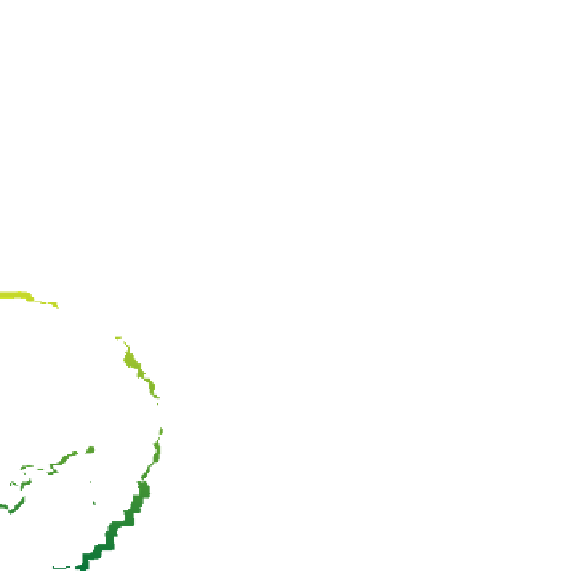Geology Reference
In-Depth Information
and can provide a connection between
these different environments.
Thousands of absolute ages are now
known for sedimentary rocks of known
relative ages, and these absolute dates
have been added to the relative time
scale. In this way, geologists have been
able to determine both the absolute
ages of the various geologic periods and
their durations (Figure 17.1). In fact,
the dates for the era, period, and epoch
boundaries of the geologic time scale
are still being refined as more accu-
rate dating methods are developed and
new exposures dated. The ages shown
in Figures 1.17 and 17.1 are the most
recently published ages as of 2004.
◗
Figure 17.25
Tree-Ring Dating Method In the cross-dating method, tree-ring patterns
from different woods are compared to establish a ring-width chronology backward in time.
STRATIGRAPHIC
TERMINOLOGY
The recognition of a relative geologic
time scale brought some order to
stratigraphy
(the study of the composi-
tion, origin, areal distribution, and age
relationships of layered rocks); how-
ever, problems still remained because
many sedimentary rock units are time
transgressive. This means that they were
deposited during one geologic period
in a particular area, and during another
period elsewhere (see Figure 6.22).
Therefore, modern stratigraphic termi-
nology includes two fundamentally dif-
ferent kinds of units to deal with both
rocks and time: those defined by their
content and those related to geologic
time (Table 17.2).
Units defined by their content
include
lithostratigraphic
and
bio-
stratigraphic units
. Lithostratigraphic
(
lith
- and
litho
- are prefixes mean-
ing “stone” or “stonelike”) units are
defi ned by the physical attributes of the
rocks, such as rock type (for example,
sandstone or limestone), with no con-
sideration of time of origin. The basic
lithostratigraphic unit is the
formation
,
which is a mappable body of rock with distinctive upper
and lower boundaries (
b
Cross section of tree showing
annular tree rings. Each tree ring
represents one year's growth. The ring
widths vary depending on the growing
conditions during the life of the tree.
a
Living tree.
1800
1850
1900
1950
2000
Present
c
By matching up tree ring patterns from numerous trees in a region, a master
tree ring chronology can be constructed. Note that these tree rings are not to
scale, but are diagrammatic to show how a master tree ring chronology would
work.
Wood beam found at an ancient site of unknown age.
1800
1850
1900
1950
2000
Present
d
Matching the tree ring pattern from a wood beam found at an ancient site to the
same pattern of the master tree ring chronology for that region, the age of the site
can be determined, at least to the time the tree died or was cut down.
rely on interbedded volcanic rocks and igneous intrusions
to apply absolute dates to the boundaries of the various
subdivisions of the geologic time scale (
Figure 17.27). A formation may
consist of a single rock type (e.g., the Redwall Limestone,
Figure 17.14), or a variety of related rock types (e.g., the
Morrison Formation, see Figure 22.17). Formations are
commonly subdivided into smaller units known as
members
and
beds
, and they may be parts of larger units known as
groups
and
supergroups
(Table 17.2).
◗
Figure 17.26). An
ashfall or lava fl ow provides an excellent marker bed that is
a time-equivalent surface, supplying a minimum age for the
sedimentary rocks below and a maximum age for the rocks
above. Ashfalls are particularly useful because they may fall
over both marine and nonmarine sedimentary environments
◗































































































































































Search WWH ::

Custom Search